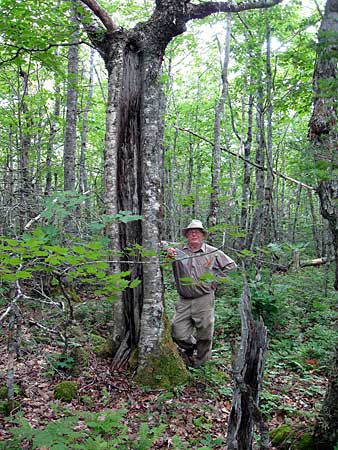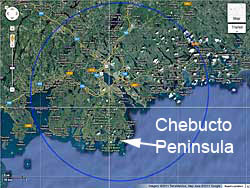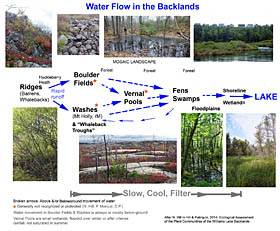David G. Patriquin
Professor of Biology (retired)
Dalhousie University
I went to Dalhousie University in Halifax, Nova Scotia, in 1973 as a marine biologist to conduct research on nitrogen cycling in coastal systems. I was hired initially as a Killam Research Fellow; in 1975 I given a tenure track position in the Biology Dept. which entailed both teaching and research.
Research-wise, I kind of "followed my nose". My discovery of a novel nitrogen-fixing bacterium associated with saltmarsh cord grass led to an invitation to collaborate with Dr. Johanna Dobereiner at EMBRAPA in Brazil on research into similar associations in tropical grasses including sugarcane. 
2009 in an Old Growth Red Oak
forest on the Chebucto Peninsula
|
The work of the Brazilian group stimulated my interest in the potential of organic farming in temperate regions for nitrogen self sufficiency. (In the 1970s, organic farming was generally viewed as suitable for subsistence farming but not for mainstream farming in North America & Europe.) I collaborated with individual farmers and groups of farmers in the Maritime provinces to investigate this topic.
In the 1980s, I became involved in the development of standards for certification of organic farms. In that connection, I acted as a 3rd party certification agent for several organic farming organizations, inspecting farms in the three Maritime provinces and Maine. I also conducted assignments related to organic farming for IDRC (International Development Research Center) in southeast Asia and Africa and collaborated with the CIPAV group in Colombia.
In the 1990s, I worked with a local landscaping company in their development of an organic approach, introducing use of white clover as a key lawncare practice.
Undergraduate Honors and Graduate students were involved in these research activities.

The Talking Classroom
Click on image to view video
|
I taught classes in Introductory Biology, Terrestrial Diversity, Microbial Ecology, Plant-Soil Relationships, Agorecosystems and Web Literacy. In the late 1990s I began to develop web applications for teaching. My initial focus was on using the web for communication outside of the classroom, thereby allowing more time for active discussion in the classroom. My all time favourite class was one in which I did no lecturing, only participated in group discussions; I called it the "Talking Classroom". In the 2000s, I headed a team that developed and delivered two fully online introductory biology classes, the goal being to facilitate more convenient access to a major introductory level class.

A circle of 36 km radius centred on
downtown Halifax defines my BioRegion
Courtesy of Google Earth. |
Circa 2004, I began to study the natural history within my bioregion which I arbitrarily defined as the region within 50 km driving distance from downtown Halifax, with a focus on the Chebucto Peninsuala
I retired in 2008. Since then, I have been active in and served on the boards of several natural history/trail/environmental organizations. I spend as much time as I can in the field, always with a camera in hand; through these activities I made or helped to make the ecological case for protection the Five Bridge Lakes Wilderness Area, two Nature Trust properties on the Chebucto Peninsula, and the Williams Lake Backlands (now the Shaw Wilderness Park). I have ongoing conservation-related activites in the Halifax Backlands, Sandy Lake & Environs (Bedford, NS), and at the French Village Conservation Woodland. I am webmaster and writer for several voluntary organizations (see below).
In the winters of 2015, 2016 & 2019 I went to Barbados and Carriacou (Grenada) to resurvey seagrass beds I had surveyed in 1969 as part of my PhD research. I am currently writing those up with my Dal colleague Bob Scheibling as co-author; Bob had also conducted PhD research in the Caribbean in days gone by. We have published two papers from the Carriacou work.
- Distribution and abundance of the invasive seagrass Halophila stipulacea and associated benthic macrofauna in Carriacou, Grenadines, Eastern Caribbean by Robert E. Scheibling1, David Patriquin, Karen Filbee-Dexter, 2018. In Aquatic Botany.
- Shifts in biodiversity and physical structure of
seagrass beds across 5 decades at Carriacou,
Grenadines by David Patriquin, Robert E. Scheibling, Karen Filbee-Dexter. 2024. In PlosOne
The latter paper took seven years from the time we started work on it until it was published (Aug 1, 2024)! I am 81. In the interest of ensuring that the 'data are not lost forever', rather than attempting to fomally publish the Barbados study, I am working on a technical report which will include all of the data, maps etc. and will be made publicly available.
While in Barbados in Jan-Mar in those years and additionally in 2017,2018, 2020 and 2023 & 2024 I conducted some semi-formal research/observations on fringing reefs in Barbados and collaborated with a reef protection group, CORALL Barbados, in the indentification of a site for a coral reef nursery, and in 2023 in the tracking the development of Stony Coral Tissue Loss Disease in Barbados.
I feel very fortunate. From my youth, my dream was to live in Nova Scotia where my family roots lie. Now I have lived most of my life here and our "kids" and grandkids are still sharing the experience. It is also a place I am still just getting to know, and to appreciate it as the ancestral and still unceded land of the Mi'kma'ki.
Education
McGill University - Macdonald Campus (1972-1973)
Postdoctoral Fellow Environmental Microbiology
Research on nitrogen fixation and denitrification in the laboratory of Dr. Roger Knowles
McGill University (1967-1971)
PhD, Marine Sciences
Thesis research on nutrient cycling in tropical seagrass beds. I was based at the Bellairs research Institute of McGill University in Barbados and was a part time lecturer at the University of the West Indies at Cave Hill, Barbados
McGill University (1964-1967)
MSc, Marine Sciences
As a graduate student (the first) of Ian McLaren, I am proud to be a member of the G. Evelyn Hutchinson lineage. Thesis research on population biology of a landlocked population of Atlantic cod on Baffin Island
Bishop's University (1960-1964)
BSc, Biology & Chemistry
During the summers of 1962-1965, I was a crew member/scientific assistant on the M.V.Salvelinus conducting fisheries, benthic and oceanographic surveys along the coast of Beaufort Sea.
Bishop's College School (1952-1960)
McGill Matriculation
As the son of a teacher at BCS, I grew up as a "school brat" on the campus of this private school in the Eastern Townships of Quebec. I only wish we valued public education sufficiently that all of our youth could benefit from an education of this sort.
Web/Social Media
Interests
Outdoor/experiential education in natural history, wilderness protection, photography, writing & admin for websites.
Award
I was given the Colin Stewart Conservation Award for 2016 by the
Halifax Field Naturalists 2016 and the Environment Stewardship Award from CARP (Canadian Association of Retirees and Pensioners) in 2017.
Publications
PDF doc
Documents on DalSpace
Google Scholar listings
Recent publication: Unusually late occurrence of a Dolichospermum bloom in a Nova Scotia lake. Linda M Campbell, David Patriquin, Michael Agbetti. in Harmful Algae News No 78, 2025, pp 10-11. PDF
Some Recent Presentations

Diagram of water flow in the Backlands
Click on image for larger version
|
Oct 28, 2024: The Natural and Not-so-Natural History of Sandy Lake (Bedford, NS)
Invited Presentation to NS Wild Flora Society
Mar 14, 2024: Vauxhall Reef 2015-2024
Invited Presentation to CORALL-Barbados AGM
Oct 26, 2023: Towards a combined Conservation/Fire Management Strategy for the Backlands For the NS Wild Flora Society
Aug 15, 2023: Wetlands, Watercourses and Watersheds of the Halifax Backlands. For Ecology Action Centre and Nature Nova Scotia Lunch & Learn
May 27, 2022: Nova Scotia's Windy Forests
Keynote presentation for Nature Nova Scotia AGM (Virtual Presentation)
Dec 3, 2020: In the Water and on the Drumlin by Bedford Lions Club Sandy Lake Beach Park. For Bedford Lions Club.
Nov 3, 2020: From Barrens and Bogs to Gardens. For the Atlantic Rhododendron and Horticultural Society
Dec 6, 2018: Natural History of the Forests and Surface Waters of Sandy Lake (Bedford, NS) & Environs
Presentation to the Sackville Rivers Association
Oct 2, 2018: The Natural History of the Halifax Backlands. For the Seniors College Association of Nova Scotia.
------
The oak drumlins of the Chebucto Peninsula
Talk for the Aethenaeum Society of Nova Scotia, Oct 16, 2017.
Multiaged old growth red oak stand on the Chebucto Peninsula
Co-author: Nick Hill. To Mersey Tobeatic Research Institute Old Forest Science Conservation Conference, Debert, N.S. Oct 19-21, 2016. PDF
Life on a rocky shore
Talk and Field Trip for Young Naturalists Club, Halifax, Sep. 19 & 27, 2015.
A Rare, Fire-Dependent Pine Barrens at the Wildland-Urban Interface of Halifax, Nova Scotia
N. Hill and D. Patriquin. Presentation at Wildland Fire Canada 2014 Conference, Halifax, N.S. Oct 6-9, 2014. Summary & Slides
Ericaceous Nova Scotia
to the The Atlantic Rhododendron and Horticultural Society, Feb. 5, 2013.
Methods of plant identification, habitats and species in the Halifax area
For the Native Plant Talk Series, May 10, 2012.
Life on a sandy shore
Talk and Field Trip for Young Naturalists Club, Halifax, Sep. 17 & 25, 2011. View links
N2 fixation by free-living and associative organotrophic
diazotrophs in marine and terrestrial habitats
to Roger Knowles Tribute Symposium at Canadian Society of Microbiologists Annual Conference, Memorial University June 20-23, 2011. Abstract
Landscapes of the Five Bridge Lakes
Wilderness Area: A Natural History
My component ("Land") of a joint presentation with Dusan Soudec on "Our new Candidate Wilderness Area by land and water" to the AGM of the Woodens River Watershed Environmental Organization Feb 17, 2010. Dusan spoke about Water.
Updated 24 Nov 2023
|



